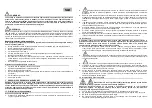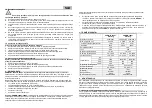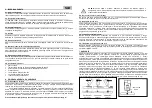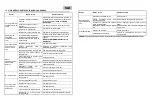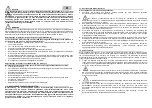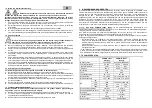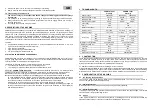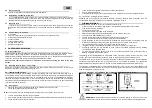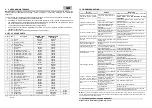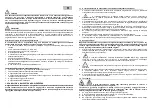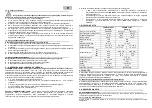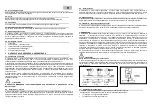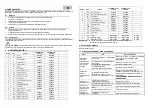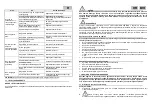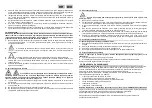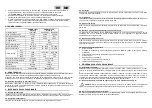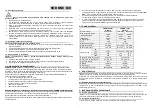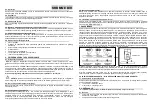
GB
IMPORTANT
This manual been written for expert operators and must be read entirely before operating the
equipment. Persons not conversant with methods and operations of the equipment should
consult the manufakturer. Do not attempt to set up, operate or service equipment if not qualified
to do so or if this manual has not been read and understood. If in doubt regarding equipment
installation and use, consult the manufacturer (technical assistance deperment).
1.0. SAFETY REGULATIONS
Electric arc welding machines made by DAIHEN VARSTROJ, meet the requirements of the ISO / EN
60974-10 standard for electromagnetic compatibility (this standard applies only on electric arc welding
machines).
The use of welding equipment and welding operations entail hazards for the operator and
third persons. The reading, comprehensions and respect of the safety regulations below are
compulsory. Remember that a sensible operator who is well aware and respectfulof his duties is the
best guarantee against accidents. Read and comply with the following regulations prior to connecting,
preparing, using or transporting welding equipment.
1.1. Installation of equipment
Compliance with the following regulations is fundamental to safety:
1. Installation and maintenance of equipment must be performed in compliance with safety standards
(ISO/ EN 60974-10).
2. Pay attention to the state of wear of socket and plug wiring; renew if necessary. Service
the equipment periodically sized wiring.
3. Connect the lead cable as near as possible to the operating area. Earth connections to structural part
of biuldings or to other places distant from the operating area will reduce their effectiveness and
increase the danger of electric shock. Do not pass eqiupment cables through or near lifting chains,
crane cables or any electrical lines.
4. Never use welding equipment near water. Ensure that the surrounding area, including any objects
therein and the equipment, is dry. Repair water leakages immediately. Do not spray water or other
liquids on the machine.
5. Avoid all direct contact with the skin or wet garments with metal parts under tension. Check that
gloves and protection are dry!
6. Always wear gloves and rubber soled shoes when working in wet areas or standing om metal
surfaces.
7. Always turn off equipment when not being used or in the event of power failure. Accidental earth
discharges may cause overheating and fire hazards. Do not leave powered equipment unattended.
1.2. Personal protection and protection of others
Welding operations are a source of radiation, noise, heat and noxious fumes; for this reason, the
protection of the operator and of third persons must be guaranteed with suitable safety devices
and precautions. Failure to observe thee regulations during operation could lead to serious health
risks.
1. Wear fire-resistant work gloves, a heavy duty long-sleeved shirt, trousers without turn-ups and shoes
with high uppers or boots to protect skin from arc rays and metal sparks and a welder's helmetor cap
to protect the hair.
2. Use a protective mask with suitable glass filter (at least NR10) to protect eyes. Take
measures to protect face, ears and neck. Advise other persons in the victinity to look away and stand
clear of arc rays and hot metal.
3. Wear ear protectors; welding operations are often noisy and may disturb other person in
the work area.
4. Always wear safety glasses with side shield, particularly during manual or mechanical removal of
slag. High temperature slag may be projected to great distances. Pay attention to fellow workers in
the victinity.
5. Position a fire-resistant screen around the welding area to protect persons in the victinity from arc
rays, sparks and slag.
6. Compressed gas cylinders are potentially dangerous; consult the supplier for correct handling
procedurs. Always protect cylinders from direct sunlight, flame, flames, sudden temperature changes
and low temperatures.
1.3. Fire and explosion prevention
Hot slag and sparks can cause fire outbreaks. Explosions and fires can be
prevented by following the procedure described below:
Clear away or protect inflammable objects and substances (wood, saw dust, clothing, paints,
solvents, petrol, kerosene, natural gas, acetylene, propan, etc.) with fire-proof material.
1. Always perform welding operations with caution, even when containers and tubes have been emptied
and thoroughly cleaned.
2. As a preventative measure, keep extinguishing equipment within easy reach, such as fire
extinguishers, water and sand.
3. Never weld or cut containers or pipes.
4. Never weld or cut containers or pipes (even open) containing or wich have contained substances that
could give rise to explosions or other dangerous reactions when exposed to humidity or heat sources.
1.4. Metal fume hazards
Welding fumes and gases may be hazardous if inhaled for long periods of time. Follow
the procedure below:
1. Install a natural or foirced-air ventilation system in the work area.
2. Use a forced-air ventilation systen when welding lead, beryllium, admium, zinc, zinc-coated or
painted materials; wear a protective mask.
3. If the ventilation system is inadequate, use an air respirator.
4. Beware of gas leaks. Shield gases such as argon are dense than air, and when used in confined
spaces will replace it.
5. In the event of welding operations in confined places (e.g. inside boilers, trenches), the welder should
be externally accompanied by another person. Always observe accident-prevention procedurs.
6. Keep gas cylinders in a well-ventilated area.
7. Close the main valve when gas is not in use.
8. Do not perform welding operations near chlorinated hydrocarbon vapours produced by degreasing or
painting; the heat generated by arc rays can reat to form phosgene, a highly toxic gas
9. Irritation of the eyes, nose and throat are symptoms of inadequate ventilation. Take immediate steps
to improve ventilation. Do not continue welding if symptoms persist.
1.5. Positioning the power source
Position equipment in compliance with the following indications:
The operator must have unobstracted access to controls and equipment connections.
Do not position equipment in confined, closed places. Ventilation of the power source is
extremely important.
1. The operator must have unobstrected access to controls and equipment connections.
2. Do not position equipment in confined, closed places. Ventilation of the power source is extremley
important. Avoid dusty or dirty locations, where dust or other debris could be aspirated by the system.
3. Equipment (including wiring) must not obstruct corridors or work activities of other personnel.


